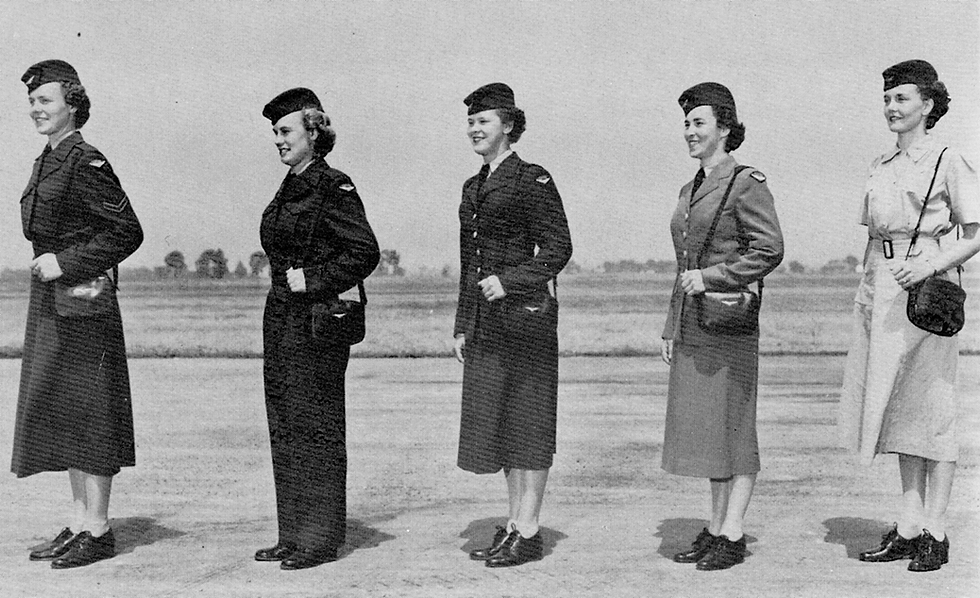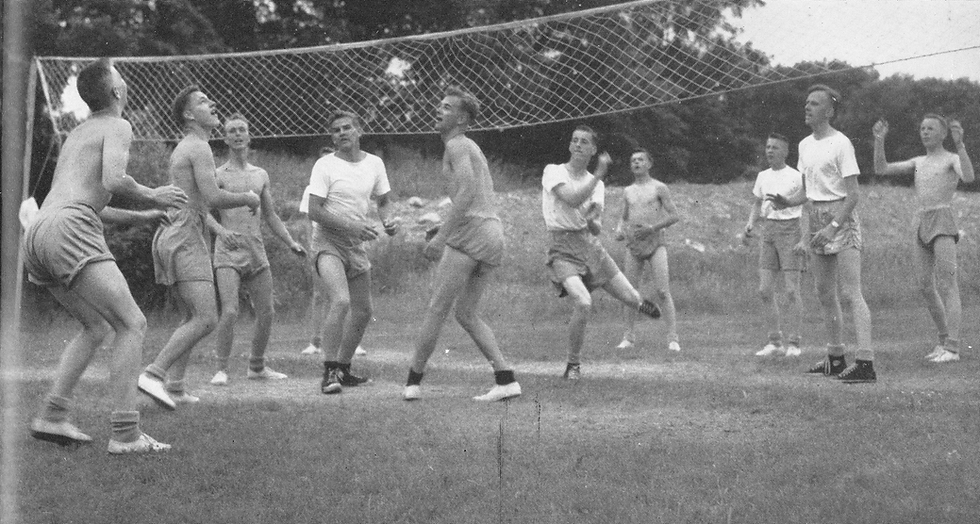Invisibility as LGBTQ+ Representation in the Canadian Air Force
- EPOCH

- Aug 31, 2024
- 7 min read
Updated: Sep 13, 2024
Nicholas Surges | Carleton University
During a research placement at the Canada Aviation and Space Museum in Ottawa, Ontario, I was struck by the seeming lack of visual sources concerning the LGBT Purge. The Purge was a campaign of surveillance, harassment, interrogation, and dismissal which targeted queer and trans people within the Canadian armed forces, Royal Canadian Mounted Police (RCMP), and civil service from the late 1950s to the 1990s. It was rooted in Cold War anxieties about espionage by Eastern Bloc states, as it was feared that LGBTQ+ people were susceptible to blackmail and thus constituted a security threat.
While the LGBT Purge Fund, which was born out of the class action settlement against the government of Canada by Purge survivors, operates a website with an archive of digitised historical sources about the Purge, these are government documents rather than images. Similarly, searching for Canada’s LGBT Purge in Google Images tends to highlight the advocacy of Michelle Douglas (whose 1990 lawsuit brought an end to Purge policies in the Canadian armed forces), the LGBT Purge Fund, and other contemporary commemorative and reparative processes rather than the historical Purge itself.

I had hoped to find evidence of Purge policies reflected in the Royal Canadian Air Force (RCAF) journal The Roundel. While there was much in The Roundel that spoke to its Cold War context – open letters by senior officers that warned of the dangers of communist ideology, quizzes that encouraged readers to review security protocols, and features on Russian military technology – there was nothing that spoke directly to the campaign of surveillance, interrogation, and dismissal targeting the LGBTQ+ community at the time. In the lifestyle features, the smiling black-and-white photos of servicepeople participating in exercises or at leisure not only betrayed nothing of the social context of the Purge, but appeared at first glance to conceal it. This conspicuous absence was striking to me and seemed worthy of investigation.

One possible explanation is that The Roundel’s silence on homosexuality and Purge policies is a reflection of its status as an official journal of the RCAF, which was thus curated to reflect its sensibilities. Op eds which might be seen to contradict its values or policy were followed by disclaimers stating that they did not reflect the views of the RCAF as an institution. Publicly admitting that homosexuality was a perceived problem in the armed forces would countermand the secrecy of Purge policies and could be seen as an admission of weakness, contributing to a culture of silence. Yet these silences are also curious. While the volumes I looked at predate the queer liberation movement of the late 1960s (which brought with it increased dialogue about LGBTQ+ issues), homosexuality had nonetheless entered public discourse even in the early years of the Cold War. Alfred Kinsey’s book Sexual Behaviour in the Human Male (1948), released in the same year that The Roundel debuted, quickly became a best seller with major publications such as The New York Times and TIME reporting on its reception. Sexual Behaviour in the Human Male dedicated a section to male sexual behaviour and famously introduced the Kinsey Scale, an assessment tool ranging from 0 (exclusively heterosexual) to 6 (exclusively homosexual) which popularised the idea that human sexual orientation exists on a spectrum. The degree to which there is no mention of homosexuality in the journal thus constitutes a suspicious absence.
But of particular interest to me was the photography featured in The Roundel. While photography appears to offer a transparency into the past, the medium conceals its own artifice: it is not always clear whether a photograph is candid or staged, and if so the degree to which it has been curated. Scholars such as Julia Adeney Thomas have reflected on these tensions. As she describes, photographs are both 'sensuous' and 'cognitive' having an immediate interpretation based on what we feel is happening in the photo (recognition) and another, more context-specific meaning that often changes as we understand more about the photo’s contents (excavation). Sometimes, this creates a clash between the photo as a subjective representation and the photograph as an index with predetermined and perhaps unknowable referents. In simpler terms, while the scene presented in a photograph may spark our imaginations, the things captured within it have fixed identities even if these are not known to the viewer. While photographs in The Roundel are typically accompanied by captions providing context, these captions do not always answer the ‘who?’, ‘what?’, ‘where?’, ‘when?’, and ‘why?’ posed by a photo. When the subjects in a photo are referred to in the abstract as 'cadets' or 'officers and men', it is difficult to identify them, frustrating attempts to search for queer histories through known biographical information.

As representations alone, these images are fascinating for the ways in which they reinforce gender norms. While The Roundel’s representations of women undergo a noticeable shift over time in response to women's re-entry into the RCAF (with the misogynist humour and objectifying photos of early issues giving way to a Feminine Gen section highlighting servicewomen’s experiences), the journal’s presentations of masculinity remain consistent throughout, highlighting athleticism and activities that have historically been masculine-coded, such as shooting, wrestling, or football. One such article in the November 1948 issue titled 'RCAF Strong Man' highlights an airman who was also an Olympian weightlifter and was careful to note both his marital status and his child. While some of these photos emphasising ideal masculinities are often unintentionally homoerotic, this speaks more to the male-dominated homosocial environment of the RCAF and the degree to which the journal seemed to presume and privilege its male heterosexual readership. Taken collectively, this content provides an acceptable template for readers to perform masculinity for their peers, giving queer servicemen in particular a formula for passing within the cis-heterosexual environment of the RCAF.

The most conspicuous examples of institutionally-sanctioned queer representations within the journal seem to be drag performances from various RCAF pantomimes, talent shows, and social outings. As representations, these are tricky to unpick. While today gender non-conformity is accepted and celebrated, images of servicepeople in drag seems to be played for humour. Images of servicemen in particular seem to suggest a Cold War-era template for acceptable drag, with unshaven legs and bushy moustaches speaking to the performers’ underlying masculinities. While these men perform femininity, I would suggest that it is accepted in large part because of its transparency: it is clear to their audiences that such instances of drag are temporary performance or vaudeville, allowing them to be tolerated for not posing a serious challenge to institutional gender norms. But are these the only queer representations within The Roundel?


We know from survivor testimony and declassified Purge documents that the Purge was happening during the late 1940s and the 1950s, coinciding with the publication of the issues of The Roundel that I examined. Here, I suggest an approach similar to Saidiya Hartman’s critical fabulation (where archival gaps can be addressed through a combination of reasonable inference and evidence from contemporary accounts). The historian can extrapolate from current statistics on homosexuality and confidently assume that some of the men and women depicted in The Roundel are likely to have been queer, even if this was not known to their fellow servicepeople and is impossible to verify. How does this allow us to think more expansively about institutional images such as this one of cadets playing volleyball, knowing that at least one of the men pictured is likely to have been queer or questioning on a purely statistical basis? And how does this knowledge coupled with the context that the LGBT Purge was underway at the time of the photo was taken complicate our reading of such images?

As representations, the photographs of The Roundel and other institutional images fail to speak directly to the Purge as a historical phenomenon. There are no photos of special investigative units conducting surveillance or of interrogation rooms where service members are subjected to humiliating interviews. But paradoxically, I would argue that this muteness bears witness by speaking to both the culture of secrecy surrounding Purge politics and the politics of passing, as servicepeople who were openly queer would be more easily caught and dismissed. As queer theorist José Esteban Muñoz argued in his landmark essay 'Ephemera as Evidence': 'Queerness is often transmitted covertly. This has everything to do with the fact that leaving too much of a trace has often meant that the queer subject has left [themself] open for attack.'
Recently, I visited the new Cold War exhibition at Canada’s Aviation and Space Museum, which includes several interpretive panels on the LGBT Purge. The team working on the exhibition addressed some of the challenges in presenting this history through the use of more recent photographs relating to commemorative efforts and the Purge settlement agreement, a satirical poster by artist Christos Pantieras which reimagined the Civil Defence Canada’s 1950s mascot Justin Case as a spokesperson for Purge policies, artefacts donated by Purge survivors, and a video interactive featuring interviews with Purge survivors.
While these are all fine strategies, I would argue that quotidian photographs such as those in The Roundel also speak holistically to the Purge and should be understood as part of this history. While it is not directly pictured, institutional photography captures the gender ideology of the Canadian Armed Forces, depicts the culture of conformity and passing, and captures the Purge through subtext. By thinking more expansively about what images speak to difficult histories, we may find new strategies for filling perceived archival gaps.
Further reading:
'About'. The LGBT Purge Fund Website. Accessed 16 May 2024. https://lgbtpurgefund.com/about/#the-purge
Adeney Thomas, Julia. 'The Evidence of Sight', History and Theory 48, no. 4 (2009): 151-68, http://www.jstor.org/stable/25621445
Kinsman, Gary, and Patrizia Gentile, The Canadian War on Queers: National Security as Sexual Regulation, (UBC Press, 2010). https://doi.org/10.59962/9780774816298
Muñoz, José Esteban. 'Ephemera as Evidence: Introductory Notes to Queer Acts.' Women & Performance: A Journal of Feminist Theory 8, no. 2 (1996): 5–16. https://doi.org/10.1080/07407709608571228
Shepard, Nikita. '‘To Fight for an End to Intrusions into the Sex Lives of Americans’: Gay and Lesbian Resistance to Sexual Surveillance and Data Collection, 1945-1972.' In Queer Data Studies edited by Patrick Keilty, pp. 49-82 (University of Washington Press, 2023)
Nicholas Surges is an emerging Canadian museum professional with an MA in History - Public History and a graduate diploma in Curatorial Studies. His research interests include Austria-Hungary, histories of sex work and homosexuality, and the study of popular representations and how they shape public memory.
Website: https://nicholassurges.com/ | LinkedIn






